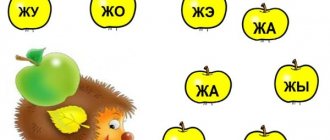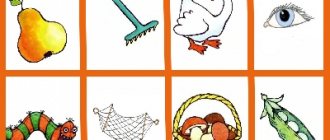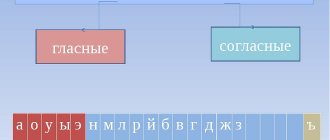The letter “Ш” is considered one of the most difficult to pronounce. To achieve clear speech in children, speech therapy classes are conducted - first on production and then on automation of hissing sounds. Working out is the final, but very important stage. It is needed for the formation of conditioned reflex connections in the cerebral cortex. When the process is completed, the child begins to speak correctly unconsciously, without any control or energy expenditure.
Using a soft sign at the end of nouns after sibilants
The letter in question is not always used to soften the sound. In some cases this is simply not required. These include the use of words with hissing words at the end, which are either soft on their own (for example, “Ch” and “Sh”), or remain hard even in the vicinity of b (“Zh”, “Sh”). At the same time, intuition and pronunciation are unlikely to help determine the need to use a soft sign with such letters at the end of nouns. You can only rely on your knowledge of spelling rules.
Functions of the soft sign in various parts of speech
Without having its own sound, b nevertheless performs several functions. His roles are varied. They depend on the part of speech in which b is used:
- At the end of nouns, the soft sign carries a softening of the preceding consonant (“reservation”, “ran”). It is also responsible for the same function in the middle of a word when using paired and unpaired consonants. Examples: string bag, ram. The same is true for verbs and adverbs. In the latter, a soft sign is placed at the end after a hissing sound in all cases, except for exception words (“unbearable”, “already”, “married”).
- The function of separation in the middle of verbs, nouns, adjectives, before soft vowels (“ya”, “yu”, “e”, “e”): “blizzard”, “ant”, “pouring”. The same applies to hard vowels in some borrowed words from other language groups: “champignon”, “papillote”, “boots”.
- Determination of morphological characteristics of words. The use of a soft sign at the end of nouns after hissing sounds indicates the III declension: gap, trembling, falsehood. Also typical for the same part of speech in the nominative and accusative cases (mouth, cane). After hissing sounds in verbs, b is placed in the infinitive (“sing”, “wait”, “cry”, “run”), the imperative mood (“cut”, “grease”, “cut”), in 2nd person verbs, singular (“read”, “speak”, “love”, “climb”).
So, the soft sign has basic functions. They come down to softening, division and designation of form. In all parts of speech it performs similar purposes.
Working in words
You need to choose only those words that contain a practiced syllable. The work is carried out in the following order:
- the sound is at the beginning;
- in the middle;
- at the end.
Automation begins with words with forward and backward syllables. It is advisable to illustrate each name, invite toys to “visit” - all this will make the lesson not only more interesting, but also more effective.
Examples of exercises
Similar to the previous stage, in the first lessons the speech material is spoken by an adult, then together with the student, and then the child repeats it independently. Gradually, when there are more practiced words, the baby names them without prompting from the speech therapist.
At the stage of automation of phonemes in words, work is carried out in parallel on the development of phonetic-phonemic processes. The child is explained where the word has a beginning, middle and end. During the classes, word diagrams are drawn up and tasks for the development of auditory self-control are offered.
At the same stage of automation, the gradual introduction of the automated phoneme into coherent speech begins. They do this using the example of phrases, Ш or Ж can be either in one or in each word:
- Repetition of words:
SHA: ball, cap, puck.
SHU: noise, fur coat, joke.
JA: toad, heat, sting.
And in this way they select words for each practiced syllable.
- The child is asked to listen carefully to the words and correct the adult. An adult deliberately makes mistakes in the pronunciation of the automated sound in some words. This task is aimed at developing auditory control of speech.
- Add the desired syllable to make a word. Pictures are used with children of primary and middle preschool age to make it easier for them to complete this task. For example, given an image of a cap and the second syllable – PKA. The child needs to add a syllable from the proposed options (SHA).
- Repetition of words with two sounds Ш or Ж. For example: bump, panties, kidding, etc.
- Repetition of phrases: On W: grandfather’s checkers, new hat, funny joke, sewing machine.
- On F: a beetle is buzzing, an orange jacket, liquid jelly.
When the child manages to pronounce the sound in words correctly, they move on to a more complex stage of correctional work - automating sounds in sentences. This block is longer in terms of the proposed material, because it is a preparation for the introduction of an automated phoneme into coherent speech.
Soft sign after sibilants in nouns
One of the most common phenomena is confusion with b after sibilants at the end of nouns. In addition to a clear knowledge of the principles of spelling a soft sign after sibilant consonants, there are several simple techniques for determining whether b is placed or not. Let us consider in more detail when its use is necessary or impossible.
When it is written
In nouns, the use of a soft sign is mandatory after sibilant consonants if the word is feminine. For example, “power”, “brooch”, “fad”, “flow”, “youth”. The rule applies to words in the nominative and accusative cases:
- Night is a capricious and unpredictable friend!
- Such power is an extremely rare phenomenon in our wilderness.
- Only a barely noticeable trembling betrayed his strong excitement.
- daughter to help you .
- Among the shelves he found soft, clean rags .
- Our short journey led to an inhospitable wilderness .
The easiest way to designate this rule is as a spelling at the end of a noun in the third declension and singular. Its signs are the feminine gender, as well as the zero ending.
When not written
Situations in which b is not required at the end of nouns after sibilants are easy to remember. There are only two of them (regarding the noun). Firstly, if the word used is in the singular masculine: “doctor”, “garage”, “beam”, “minced meat”. Secondly, the plural: “many roofs, several clouds, in the middle of abandoned dachas.” The following diagram most fully reflects this rule:
Lists of individual rule clauses
Yo at the root:
string hard, wool, whisper, study, millet, cheap, silk, lattice, bangs, acorn, millstone, honor, dash, bees, black, yellow, gutter, perch, brush, cheek, tap dance, hairstyle, shuttle, crack, came , liver, dandy, click.
About at the root:
anchovies, artichoke, borjomi, joker, junk, joule, jockey, juggler, zhor, heartburn, hood, gherkins, gooseberry, cruchon, major, glutton, rattle, slum, thicket, clink glasses, crazy, prim, clink, seam, chauvinism, shock, chocolate, ramrod, rustle, shorts, blinders, highway, Scotsman, driver.
O in noun suffixes:
canvas, brocade, reed, shirt, vest, girl, river, little hand, little box, little dog, little shop, little soul, penny, little book, little piece of paper, little barrel, little clothes, little hat, little hat, little thousand, little boy, little old lady, little bear, little mouse, little pebble, little frog, little rook, little chick, little squirrel, little camel, little rabbit, little walrus, little snake, little dog, little wolf, little barrel, small little wolf, little birdling, little cuckoo, little turkey, grandson, little spider, shred, net, jump, bunch, snowball, curd, heel ok icon, knot, shoe, cricket, old man, Cossack, pie, sailor, fist, worm, hook, onion, goby, bug, zucchini, tank, tobacco, pike perch, jacket, cap, pupil, fool, piglet, newcomer, peasant, fontanelle, old man, click, top, barrel, garlic, spider, chest, pod, tongue, bow, firefly, hamster.
O in adjective suffixes:
kumach, sealing wax, comb, cherry plum, noodle, ruff, bream, canvas, borscht.
O in noun endings:
a cloak, a weaver, a bearded man, a brick, a strongman, a penny, a ball, a sword, a ray, a key, a knife, a shoulder, a doctor, a tractor, a hut, reeds, a ladle, borscht, bream, luggage, a broadsword, a garage, a circulation, a rook, a ladle, floor, wax, hedgehog, weaver, a knock, cartilage, whips, pimple, ticks, goulash, white -white, ruff, ershom, owl, paralysis, Muscovite, executioner, rumor, dashing, scammers, strogach, plug -in, trickers, circus, violin. border, rack, whip, dugout, division, turn, snake, rein, boundary, locust, candle, brocade, kalancha, noodles, soul, melon, noodles, sling.
O in the endings of adjectives:
big, alien.
O in adverb suffixes:
fresh, hot.
Yo at the endings of verbs:
cuts, cuts, sets fire, protects, cuts, bakes
Yo in suffixes of verbal nouns:
overnight, uprooting, stew, condensed milk, demarcation, length.
Yo in suffixes of participles and verbal adjectives:
truncated, doomed, soaked, distressed, lit, baked, dried, crushed, embarrassed, indignant, dejected, simplified, extended, tense, liberated, protected, heated, completed, exhausted, smoked, baked, delimited, shaded, detached
Suffix ЁР:
intern, groomer, retoucher, conductor, massager, trainer.
Algorithm for identifying words with and without a soft sign
Often doubts about the need to use b arise during auditory perception. It is especially difficult with unknown or rarely used words. The procedure below will help you determine whether a soft sign is being written:
- Understand which part of speech the word belongs to. Sometimes belonging to a verb or adverb gives an excellent clue. If it is defined as a noun, then you can proceed to the second step.
- Determine gender. The rules of spelling are adamant: if the word is feminine, there must be a spelling. If masculine, there is no soft sign at the end.
- Consider the number. Only the singular word can boast this sign at the end. But this is intuitively clear: “what a beautiful thing” (III sc.) - “on one of the steep slopes a flag fluttered” (I sc.).
If the word is unusual, for example, the author’s (invented one), then the context and environment will help determine the part of speech, gender, number. Example: in the fictitious phrase “dyabryaky tuzh” the main word is devoid of b, since the adjective next to it indicates the masculine gender with its ending. In another example of such authorial content, “meow douche” implies the feminine gender, and therefore b is necessary.
The role of the soft sign, its purpose in various parts of speech, and cases of use are described above. Using this letter will not cause any difficulties if you follow the given algorithm of actions. Simple rules will help not only the correct spelling of generally accepted words, but also the bold use of unfamiliar and proprietary words.
When is b written after sibilants in a verb?
“We ALWAYS write a soft sign after hissing verbs!”
Textbooks most often list that “b” is written if the verb is in the infinitive (answers the question, what to do? or what to do?), in the second person singular (combined with the pronoun you) or in the imperative mood (indicates for action). It is not necessary to remember all this, since in all other forms there are no hissing words at the end. Let's look at examples. Infinitives: attract, burn, lie down. Second person, singular: write, love, breathe. Imperative form: cut, spread, eat!
By the way, a soft sign can appear not only at the end of verbs. When adding –sya and –te after the hissing letter “b” it is preserved. For example: cut, smear, fall in love.
The most popular mistake with a soft sign in verbs is writing it between -t and -sya in different persons. If we write “to shave” (what to do? with a soft sign), then we will write “shaves” (what does it do?) without b. The rule is simple: “ If a question has a “b” at the end, then we also write a soft sign between –t and –xia. “We remember that the letter T is not a hissing letter, so this rule is not entirely on the topic of the article. We looked at verbs. Let's move on to nouns!
What you need to know about sound automation?
The peculiarities of speech development are such that the child first begins to pronounce an isolated sound. Correct pronunciation of words and sentences is more difficult for children and requires some effort. For example, you can often encounter a situation where a baby hisses “Shhh” clearly and clearly, but instead of “hat” he continues to say “sapka”. Or, in a calm state, he pronounces words correctly, but when he is emotionally excited, he begins to “swallow” or replace sounds. This means that conditioned reflex connections in the cerebral cortex are not fully formed. To complete the process and bring correct pronunciation to automaticity, training is needed.
Automation of hissing sounds is carried out in stages in a certain sequence. First, the [w] is staged, the details of which can be found here. After the child pronounces a separate sound correctly, it is practiced:
- in syllables;
- in words;
- in sentences;
- in verse;
- in stories;
- in independent speech.
It is important to follow this sequence. You cannot move to the next difficulty level if the sound on the previous one has not yet been mastered. The child will make mistakes, and this can lead to the formation of incorrect conditioned reflex connections.
Soft sign after sibilants at the end of nouns
The rule is quite simple:
“b is written after hissing nouns at the end ONLY if the noun is feminine singular!”
In all other cases, b is NOT written after hissing nouns at the end.
Let's look at examples. With a soft sign after hissing ones: Rye, night, lie, thing, daughter. “The queen gave birth that night to either a son or a daughter.” A.S. Pushkin. The feminine singular can be determined by substituting the pronoun “my”. My daughter, my lie, my whim.
Without a soft sign: Doctor, knife, many clouds, many pears, brick, roll, scarecrow, Alexander Sergeevich. “Above him is a golden ray of sun…” M.Yu. Lermontov.
As we see, the soft sign is not written after masculine singular nouns, in plural nouns, or at the end of masculine patronymics. It is easier to remember when a soft sign is written in nouns than when it is not written







